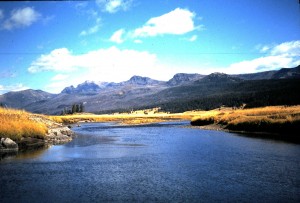Slough Creek
SLOUGH CREEK
When run-off leaves Yellowstone Park’s Slough Creek, it becomes a destination from July through September for fly-fishers from all corners of the world, especially to encounter Yellowstone cutthroat trout. Just viewing Slough Creek is a pleasure, and not having a high resolution camera when fishing it is a mistake. Few places anywhere can be a better example of a meadow stream, and it is the stair-step meadow reaches of this stream that attract so many fly-fishers. The first meadow is approached from the access road beginning at the Northeast Entrance Highway and ending at Slough Creek Campground, a distance of a few miles. Needless to say this meadow reach gets “hammered” because of being beside or not far from a well maintained road. In addition to cutthroat trout, this part of the stream also holds cutthroat-rainbow hybrid trout, and Yellowstone Park now requires that these be killed. Not far above the campground, Slough Creek passes over a steep cascade which prevents, on a natural basis, these hybrids from entering the stream above. Above the cascade Slough Creek flows through two breath taking meadows, known unofficially as “first above” and “second above.” When traveling to the campground from the highway, one passes the trail head and parking lot for reaching these meadows. An entertaining past time here is to see how many states, provinces, or countries are represented by visiting fly-fishers. At times little parking space remains there, so popular is the stream in the two meadows above. But the further upstream a fly-fisher is willing to venture, the less company that person will experience. The lower of these two meadows requires a walk of about two miles up a well maintained trail which also serves as a tote road for supplying a ranch north of and predating Yellowstone Park. The stream in the upper and larger meadow requires about another three more miles of effort to approach. A good strategy for enjoying the stream in the upper meadow is to reserve one of the primitive campsites to use as a base of operations for an overnight or longer visit. The rewards for efforts to fish the stream in either meadow is a population of essentially only Yellowstone cutthroat that range up to trophy sizes. As previously mentioned, the fly-fishing season here is best when run-off leaves. That is usually before the first of July, but can be later following heavy snowfall winters. Yes, there is the early season progression of mayflies (and later in the season that of tricos) and responding trout here, as is the case on many Greater Yellowstone Area streams. But where Slough Creek really comes into its dry fly fishing own is when terrestrial insects become important in the trout’s diet. That usually begins as the meadows dry out in July. At that time a much overlooked opportunity comes from presenting patterns for mating and egg-laying damselflies on the stream. Success during times when trout take terrestrial patterns has a major requirement: the angler must keep out of sight of feeding trout. One must remember that these trout inhabit the water “24-7,” and any temporary change in their field of vision puts them into flight mode. Thus long casts, a low profile, gentle stepping, and subtle use of sunlight are required where even a person barely five feet tall can be the most prominent object around. Want to lessen these requirements? Try fishing waters in the timber reach between the two meadows. There is a background of tall timber here, and shelter from winds and intense sunlight. In my experience the trout are not as cautious as those in the stream out in the meadows, and you will have fewer interruptions from other fly-fishers. So if you have yet to visit this superbly attractive stream, put in on your “to-do” list. Also we can help you with strategy details.


